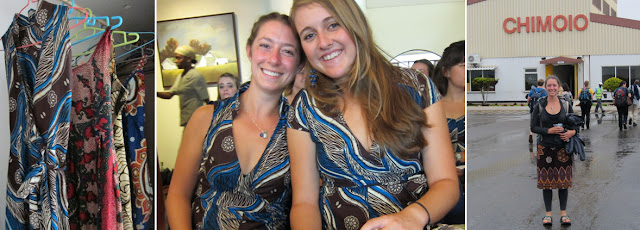Hi, my name is Anna, and I am a
capulana addict. Only three and a half months in Mozambique and I am completely hooked on the swaths of colorful fabric that seem to hold life itself together here. Before I arrived, I had been told that it was cheap and easy to buy fabric here and have clothing made, so I packed with the plan to find a tailor who could make some skirts and dresses for school. I had also heard from volunteers in-country that there were miraculous pieces of cloth that could be used for just about anything from curtains to yoga mats, but I didn't really understand the magic of the capulana until I first held one in my hands. I bought a few to make dresses and was immediately enamoured. To be honest, I still don't fully understand the spell they have cast on me, but I know I can't stop buying them.
 |
| My collection (I swear I have a plan for each); capulanas make for beatiful laundry; my soon-to-be kitchen curtains. |
Capulanas are basically pieces of fabric about a yard wide, cut from a long roll. They come printed with patterns that range from bright and blocky to subtle and intricate. Many have beautiful borders that immediately make me want to turn them into a skirt. Some commemorate holidays, Mozambican heroes, or political parties. You can find them tie-dyed and batiked, on fine fabric or cheap rayon. The possibilities are endless.
 |
| Our host maes teaching us how to run a Mozambican house in their capulanas. |
The uses are just as limitless. The primary use among Mozambican women is as a traditional wrapped skirt, as above. Women wear them while working in their
machambas, around the house, when in mourning, or just about any time. In this form, they aren't seen as formal clothing appropriate for professional women, but luckily, they can also be used to create skirts, dresses, shirts and pants which can be worn in just about any setting. Even men wear capulana shirts and pants, although the pants are considered casual. I have already had three dresses and a skirt made for 200 and 100 meticais each, respectively, or about $7 and $3.50. One of the technical trainers during PST had some of the most fantastic outfits made from capulanas. She even had one made to match the capulanas we received from our host families and wore it to our homestay celebration.
 |
| Most of our training team, including Ana Paula's fabulous capulana outfit; Rafael and Edna at our homestay celebration in his capulana shirt. |
The second most common use I have seen is to carry babies. Adorable little Mozambican children are slung around their mother's backs with their adorable little feet sticking out. Much easier and cheaper than a baby-bjorn, but to much the same effect. You also see older siblings carrying their brothers and sisters wrapped in capulanas on their backs, or as below, carrying their dolls when no child is available (only saw that this once, though). You would be amazed at the work that Mozambican women can accomplish with an infant capulana'd to their backs.
 |
| There is no such thing as an ugly Mozambican baby. Or child. At least as far as I have seen. |
And capulanas find nearly infinite uses beyond clothing and baby slings. They serve well as curtains, tablecloths, and towels. Drape one over a cardboard box and - voila! - a perfectly good Peace Corps bedside table. Our Mozambican technical trainer gave a mini-lesson on force using a knotted capulana for tug-of-war. One visiting volunteer describe one of his methods to deter cheating during an exam using a capulana: he didn't want any students to have their materials near their desks, but they are extremely protective of their backpacks and refuse to put them directly on the ground. Once he covered a corner of the class with a capulana, he could finally convince them to pile up their bags on the cloth and could proceed with his test. I am starting to wonder how we make it without them in America.
 |
| My capulana curtains; a capulana tablecloth; capulana sheets - perfect for a cat nap (sorry!). |
Since they are so useful, and so beautiful, I find it hard to stop buying them. Luckily, a good one only costs around 120 meticais, or just over $4. Seems worth it to me...
 |
| The capulana dress section of my closet; Anneke and I matching at swearing-in; arriving in Chimoio in style. |






Referência sobre a importância da capulana...
ReplyDelete